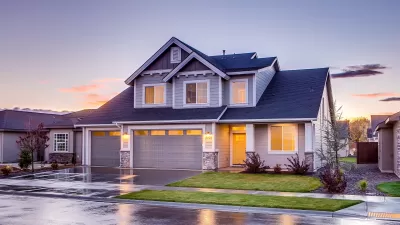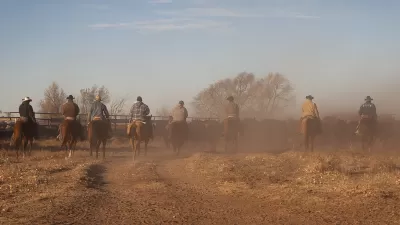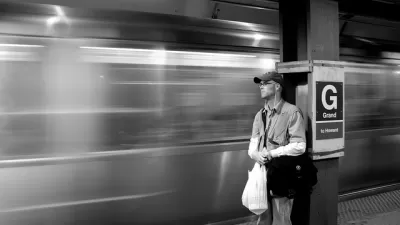According to a new report, U.S. transit ridership increased to 10.5 billion rides in 2012 - a 1.5% increase over 2011, despite transit shutdowns and reductions caused by Superstorm Sandy. High gas prices, and their volatility, was a major cause.
USA Today reporter Larry Copeland also pointed to the importance of the improving economy (more people going to work) and changing demographics as a reason for transit's growing popularity, "especially among Baby Boomers, empty-nesters and Millennials, who total about 150 million people."
As for the other reason, American Public Transportation Association President and CEO Michael Melaniphy "says the increase in transit ridership was driven, at least partly, by high gas prices, the volatility of those prices" in addition to the "nation's changing demographics."
The gas price explanation for increased transit ridership is not shared by a State Smart Transportation Initiative report posted here that analyses declining vehicle-miles-traveled. Many reasons are given while fuel prices are categorically rejected.
Copeland cited the Sound Transit light rail in Washington state as an example of the increased ridership. It "soared 12% last year to just over 28 million — a record in the agency's 14-year history, spokesman Bruce Gray says."
Why did 2008 set the record? Americans were unprepared for gas prices over $4.00 gallon. A better comparison for the record might be "the second highest ridership since 1957" according to the APTA press release.
If transit is going to keep up with the increased demand, additional funding will be needed - and the news is good there, according to the press release:
Melaniphy also pointed out that more Americans are supporting public transportation investment, as evidenced by the large number of transit-oriented ballot initiatives that passed in 2012. “Last year 49 out of 62 transit-oriented state and local ballot initiatives passed,” said Melaniphy. “That means there was a nearly 80 percent passage rate. This extremely high rate of success demonstrates how important public transportation is to people and to communities.”
The press release also breaks down the ridership increase into four transit modes:
- Light rail (modern streetcars, trolleys, and heritage trolleys) ridership increased 4.5 percent with 21 out of 28 transit systems reporting increases.
- Heavy rail (subways and elevated trains) ridership increased by 1.4 percent across the country as 10 out of 15 transit systems reported increases.
- Commuter rail ridership increased by 0.5 percent as 18 out of 28 transit systems reported increases.
- Large bus systems reported an increase of 1 percent and 29 out of 38 large bus systems reported increases.
Curtis Tate of McClatchy Newspapers points out that the improving economy is key to transit usage - and that exposes why not all transit systems are posting ridership increases. "About 60 percent of transit trips are to and from work, according to the public transportation association".
(W)hile many transit systems posted large gains, others saw a decline, reflecting the unevenness of the economic recovery. And declines in the state, local and federal tax revenues that support transit systems have forced many of them to cut back service.
FULL STORY: Public transportation hits 10.5B rides in 2012

Study: Maui’s Plan to Convert Vacation Rentals to Long-Term Housing Could Cause Nearly $1 Billion Economic Loss
The plan would reduce visitor accommodation by 25,% resulting in 1,900 jobs lost.

Alabama: Trump Terminates Settlements for Black Communities Harmed By Raw Sewage
Trump deemed the landmark civil rights agreement “illegal DEI and environmental justice policy.”

North Texas Transit Leaders Tout Benefits of TOD for Growing Region
At a summit focused on transit-oriented development, policymakers discussed how North Texas’ expanded light rail system can serve as a tool for economic growth.

Paris Bike Boom Leads to Steep Drop in Air Pollution
The French city’s air quality has improved dramatically in the past 20 years, coinciding with a growth in cycling.

Why Housing Costs More to Build in California Than in Texas
Hard costs like labor and materials combined with ‘soft’ costs such as permitting make building in the San Francisco Bay Area almost three times as costly as in Texas cities.

San Diego County Sees a Rise in Urban Coyotes
San Diego County experiences a rise in urban coyotes, as sightings become prevalent throughout its urban neighbourhoods and surrounding areas.
Urban Design for Planners 1: Software Tools
This six-course series explores essential urban design concepts using open source software and equips planners with the tools they need to participate fully in the urban design process.
Planning for Universal Design
Learn the tools for implementing Universal Design in planning regulations.
Smith Gee Studio
Alamo Area Metropolitan Planning Organization
City of Santa Clarita
Institute for Housing and Urban Development Studies (IHS)
City of Grandview
Harvard GSD Executive Education
Toledo-Lucas County Plan Commissions
Salt Lake City
NYU Wagner Graduate School of Public Service





























